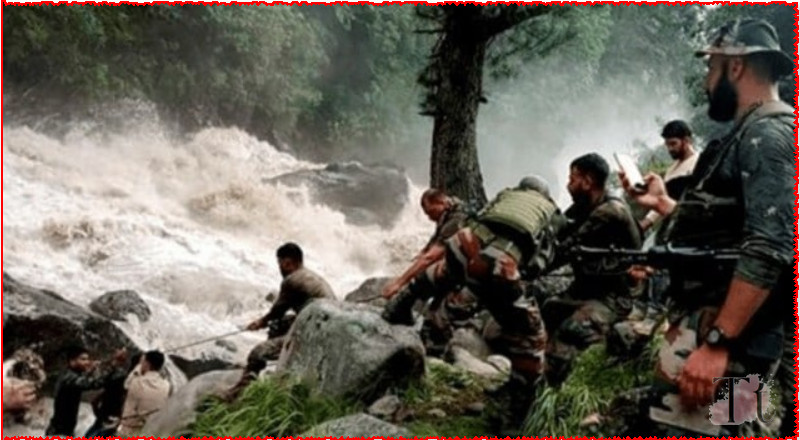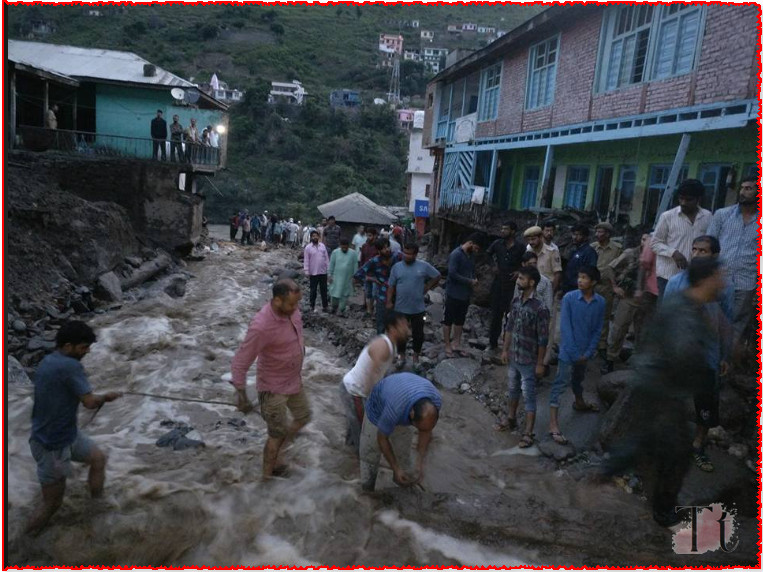The provided content reports on a severe weather event that occurred in Thathri, a town in the Doda district of Jammu and Kashmir, India. Early in the morning on June 29, 2024, around 3 AM, a cloudburst resulted in flash floods and substantial mudslides, significantly impacting the Thathri market, several residential houses, and parts of the Batote-Kishtwar National Highway. Despite the severe damage caused by this event, fortunately, there were no reports of injuries or fatalities.
Table of Contents
Understanding Cloudbursts
A cloudburst is an intense and sudden precipitation event, usually over a localized area, where a large amount of rain falls within a short period. These events are characterized by their potential to cause flash floods, as the rapid accumulation of water overwhelms the drainage capacity of the affected area. Cloudbursts are often associated with thunderstorms and lightning, which adds to their potential for causing widespread damage. This phenomenon occurs when warm air currents carry large amounts of water vapor to high altitudes, where the vapor condenses rapidly, resulting in heavy rainfall.

Detailed Impact on Thathri Town
The cloudburst in Thathri led to flash floods that triggered substantial mudslides. These mudslides caused extensive damage to the Thathri market and several residential houses. Vehicles were trapped in the debris, and significant disruption occurred on the Batote-Kishtwar National Highway, a vital route for the region. The sudden and intense nature of the cloudburst caused panic among the residents, bringing back memories of a similar incident in 2017 that also caused extensive damage and panic among the residents.
Immediate Response by Authorities
Masood Ahmed Bichoo, the Sub-Divisional Magistrate (SDM) of Thathri, reported that the flash floods and mudslides were extensive due to the sudden cloudburst. However, the impact occurred near a less populated Army gate area, which helped reduce the potential for greater loss of life and property. Despite the significant debris and disruption caused by the mudslides, no major losses were reported, and restoration work began promptly. The traffic on the highway was partially restored, and efforts to clear the debris from the market area were expected to be completed by the afternoon.
Historical Context: The 2017 Cloudburst
The 2024 cloudburst in Thathri reminded residents of a similar event on July 20, 2017. During this earlier incident, a cloudburst caused significant damage in Thathri town, washing away structures near the Jamia Masjid and injuring several people. This historical context highlights the region’s vulnerability to such weather events and emphasizes the recurring challenges in managing their aftermath. The 2017 cloudburst left a lasting impact on the community, and the memory of that event added to the panic and urgency of the situation in 2024.
Detailed Account of the 2024 Incident
Residents reported experiencing heavy rainfall and lightning around 3:30 AM. The mudslides brought loose soil from the surrounding hill slopes into the town, causing muck to flow onto roads and into homes and shops. This sudden influx of water and soil led to panic among the local residents. Vehicles parked in the affected areas were filled with muck, and the busy Batote-Kishtwar National Highway was submerged, halting traffic.
Restoration and Cleaning Efforts
Following the incident, the district administration, led by SDM Masood Ahmed, promptly initiated restoration and cleaning efforts. By evening, the mud that had entered homes and shops was cleared. The mudslides also affected six to seven internal roads, adding to the challenges of restoring normalcy. The restoration work involved clearing debris and muck from roads and homes, with men and machinery working continuously. There was also a warning of more rainfall in the region, which added urgency to the restoration efforts.
Community Impact and Response
The cloudburst had a significant impact on the local community. Residents like Irfan Majeed described the difficulties they faced, with water and muck entering their homes and making it challenging for elderly residents to move. Clearing the muck took several hours, and there was concern about the potential for further rain worsening the situation. This incident highlights the immediate and long-term challenges faced by the residents in the aftermath of such natural disasters.

Broader Implications
The incident in Thathri underscores several broader issues that need to be addressed to mitigate the impact of such events in the future:
- Climate Change and Weather Extremes: The increasing frequency and intensity of extreme weather events, such as cloudbursts, are attributed to climate change. These events pose significant risks to vulnerable regions, especially those with inadequate infrastructure to handle sudden surges in rainfall. The Thathri incident is a clear example of how climate change can exacerbate natural disasters, leading to more frequent and severe impacts on communities. The changing climate patterns have resulted in more unpredictable and intense weather events, which are becoming increasingly difficult to manage.
- Infrastructure and Preparedness: The impact on Thathri highlights the urgent need for improved infrastructure and preparedness to manage such events. This includes developing better drainage systems, establishing early warning mechanisms, and implementing robust disaster response strategies. Enhanced infrastructure can help mitigate the damage caused by such events, while preparedness measures can ensure a swift and effective response to minimize their impact. Investments in resilient infrastructure, such as reinforced roads, effective drainage systems, and flood barriers, are essential to reduce the vulnerability of regions prone to extreme weather events.
- Community Resilience: Building community resilience is crucial to mitigating the impact of such natural disasters. This involves educating residents about emergency preparedness, improving local infrastructure, and ensuring timely and effective response from authorities. Community resilience can be enhanced through continuous engagement with residents, regular drills and training sessions, and by fostering a culture of preparedness and vigilance. Educating the community on how to respond to early warnings, creating community emergency response teams, and having well-defined evacuation plans can significantly improve the community’s ability to cope with such disasters.
The cloudburst in Thathri, Doda district, serves as a stark reminder of the power of nature and the challenges posed by extreme weather events. While the immediate response by the authorities helped prevent major losses and restore some normalcy, the incident underscores the need for ongoing efforts to improve infrastructure, preparedness, and community resilience. As climate change continues to influence weather patterns, regions like Thathri must adapt to manage the risks and protect their communities from future natural disasters. Ensuring that infrastructure improvements are made, early warning systems are in place, and the community is well-prepared can help mitigate the impact of such events and safeguard the lives and properties of the residents.
Extended Discussion on the Impacts and Future Directions
The Role of Climate Change in Extreme Weather Events
The increasing occurrence of extreme weather events like cloudbursts is closely linked to the broader issue of climate change. As global temperatures rise, the atmosphere’s capacity to hold moisture increases, leading to more intense and frequent rainfall events. This phenomenon contributes to the increasing frequency of cloudbursts, which can have devastating impacts on communities, especially in mountainous and hilly regions like Thathri. Climate scientists predict that such extreme weather events will become more common as climate change progresses, necessitating urgent action to mitigate their impacts.
Infrastructure Improvements
To effectively manage the risks associated with cloudbursts and other extreme weather events, significant investments in infrastructure improvements are necessary. This includes upgrading drainage systems to handle large volumes of water, reinforcing buildings and roads to withstand mudslides, and constructing barriers to protect vulnerable areas from flooding. Additionally, the implementation of advanced weather forecasting and early warning systems can provide communities with timely information to prepare for and respond to impending disasters. The development of resilient infrastructure not only reduces the immediate impact of such events but also contributes to long-term community stability and safety.
Community Preparedness and Education
Enhancing community preparedness through education and training is essential to improving resilience to natural disasters. Communities need to be aware of the risks they face and the steps they can take to protect themselves. This includes understanding early warning signals, knowing evacuation routes, and having access to emergency supplies. Regular drills and training sessions can help residents respond effectively in the event of a disaster. Engaging local leaders and organizations in these efforts can ensure that preparedness measures are tailored to the specific needs and vulnerabilities of the community.
Policy and Governance
Effective governance and policy-making play a critical role in addressing the challenges posed by extreme weather events. Governments at all levels need to prioritize disaster risk reduction and climate adaptation in their planning and development agendas. This involves integrating climate risk assessments into infrastructure projects, enforcing building codes and land-use regulations that reduce vulnerability, and providing resources and support for community-based resilience initiatives. Collaborative efforts between government agencies, non-governmental organizations, and the private sector are necessary to develop comprehensive strategies that address both immediate and long-term risks associated with extreme weather events.

Conclusion
The cloudburst in Thathri, Doda district, highlights the urgent need for a multifaceted approach to managing the risks associated with extreme weather events. While the immediate response to the 2024 cloudburst helped prevent major losses, the incident underscores the importance of ongoing efforts to improve infrastructure, preparedness, and community resilience. As climate change continues to influence weather patterns, regions like Thathri must adapt to manage the risks and protect their communities from future natural disasters. By investing in resilient infrastructure, enhancing community preparedness, and implementing effective policies, we can mitigate the impacts of such events and safeguard the lives and properties of vulnerable communities.


1 thought on “Thathri Cloudburst 2024: Severe Impact and Response”